Making Open-Crock Sauerkraut (or how to ferment just about any vegetable)
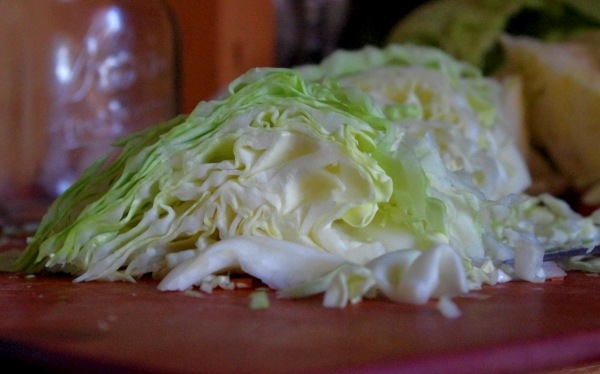
A year is how long it has taken me to sink into this new home here in central Texas. I can tell that I’m just above treading water when a few funny looking jars of stuff start sitting around my kitchen, all fermenting.
Milk kefir has been happening for a while now, though I’m not so sure those grains are as sturdy as they ought to be. Kombucha has been brewing for months now, off and on, in large two-gallon glass crocks. Sourdough is forming next to the wood stove for pancakes and bread.
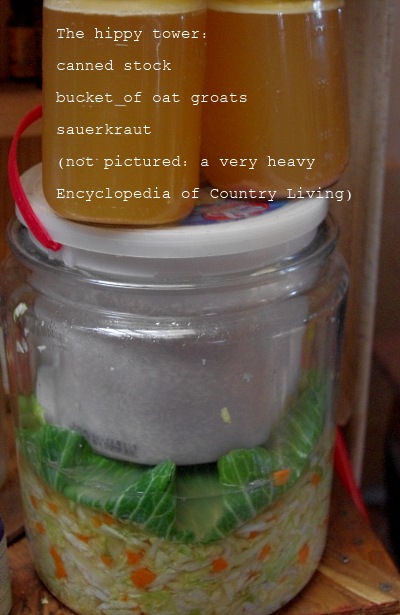
And then there’s this sauerkraut. These days, without much coming from our own garden needing to be put by, I make vegetable ferments for the sake of our health and my sanity and in doing so it solves a few problems for me:
- I can only fit a couple of veggies in our little solar refrigerator so it’s either don’t eat veggies or shop more frequently. And I do. not. like. going. to. town.
- It eliminates the guilt of me throwing together a meal that doesn’t include a raw or fermented veg, which can happen frequently (see point number one).
- Even if I do have said vegetables I can throw a plop of sauerkraut on someone’s plate when we’re in a hurry and know that we’ve got some enzyme action happening.
.jpg)
Being a fermented foods enthusiast I have made batches and batches of sauerkraut over the years, no two being exactly alike. I’ve also experimented with various techniques. I started with the quart jar method years ago in which you pound cabbage with salt until it relinquishes all of its juices. This was a good activity for the little men, but I have since found it unnecessary.
I then experimented with what some call the open-crock method. This is the method our ancestors would have most likely used. The cabbage is weighted down in a crock that is left unsealed. The kraut stays below the water level, which allows it to culture anaerobically while the surface of the brine is still exposed to a flow of air.
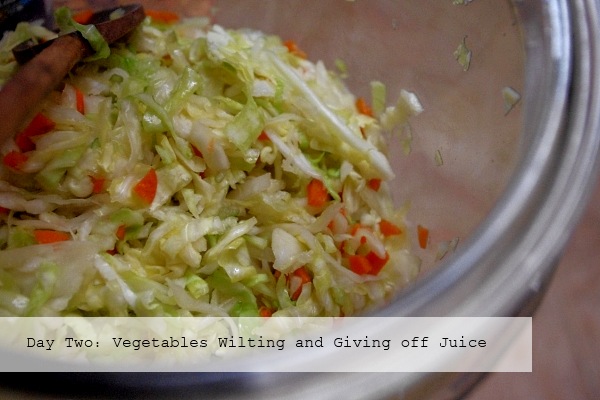
Is Open-Crock Sauerkraut Bad?
Now I realize that a bunch of people got their underpants in a knot earlier this year over whether or not cultured vegetables should have their brine surfaces exposed to air, even the small amount that comes in when one "burps" their glass jars.
If it is your underpants that are in said knot then let me assure you that…
- This is a first world problem.
- I’m interested in sustainability, not big-worded fancy pants science talk.
- A raw fermented vegetable, in whatever vessel you choose to ferment it in, will most likely contain some probiotics and enzymes.
- Vegetables have always been fermented for more important reasons than achieving a higher LAB count.
Now that everyone’s underpants are back where they belong, let’s move on.
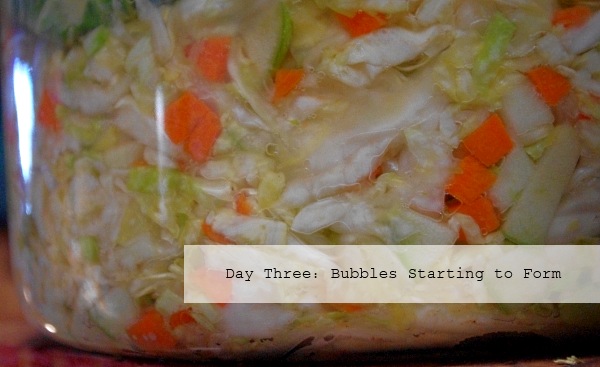
The Universal Principles of Vegetable Fermentation
So anyways, I discovered that this open-crock method for making sauerkraut also produced a much better tasting kraut than those batches I made in quart jars. A few other principles I keep in mind in order to make tastier vegetable ferments that we’re all happy to eat (and make) are:
- Don’t use too much salt. Most of the fermented vegetable recipes in Nourishing Traditions use way too much salt, in my experience. When you are mixing up your veggies to culture taste them. They shouldn’t taste of salt. They should taste like vegetables that have been salted generously, not obnoxiously.
- Don’t ferment in warm temperatures. I used to place jars next to the radiators in our old home to ferment. Once I started fermenting in the low 60 degree range, I found that the vegetables stayed crisp and the slower fermentation time developed better flavor.
- Don’t make it harder than it needs to be. Recipes are great if you’re first starting out, but if your first few experiences with fermented vegetables involve tedious amounts of unnecessary chopping, grating, or pounding of ten different ingredients then you’re not likely to do it again.
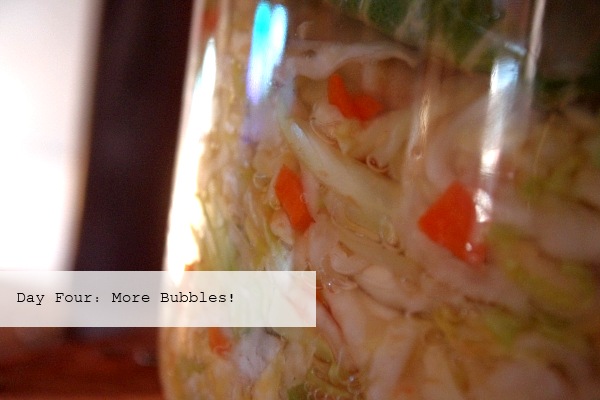
Open-Crock Sauerkraut Recipe
Ingredients
- 3 large heads of cabbage
- 3 green apples
- 5 large carrots
- sea salt
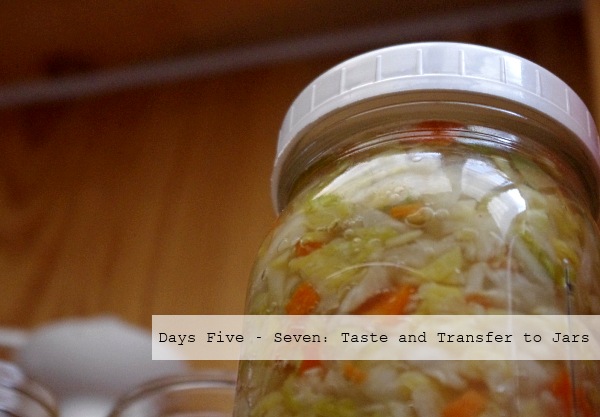
Directions
- Prepare a large non-reactive vessel such as a bowl or a crock. Prep cabbage by removing any outer leaves with bad spots, halving, and coring. Thinly slice cabbage as if you were preparing coleslaw. Place in bowl with a couple of generous sprinklings of sea salt.
- Core apples, slice thinly, and then cut into bite-sized chunks. Add to cabbage with another small sprinkling of salt.
- Cut carrots in half length-wise and then into thirds length-wise. Dice and add to cabbage-apple mixture. Mix all ingredients very well.
- Taste. If it is a bit bland add more salt and mix well until it tastes of a well-salted vegetable.
- Place in bowl or crock and place a plate, bowl, or other non-reactive dish that fits just inside the vessel. On top of that dish place a few clean, heavy, non-reactive objects. These will weight the plate or dish down which will allow the vegetables to stay below the level of the brine. Cover the whole lot with a clean kitchen towel to keep bugs out.
- After about 24 hours check to make sure that a brine has formed in order to cover the cabbage. If not, prepare a brine by combing 1 pint of water and 1 tablespoon of sea salt. Remove the weights and dish and pour brine over kraut. Place dish and weights back on top of kraut and cover again with towel.
- Allow to culture at a cool room for at least four days. If you are culturing in a cellar or basement then you can simply allow it to continue to culture for weeks and months, removing any impurities that come to the surface of the brine. If you are doing it at room temperature then after it has cultured for 4-7 days you can transfer it to jars for storage in a cellar or refrigerator.
How do you make sauerkraut?


Can I tell you how much I loved this post? First up, people forget what the rest of the world lives like, so it totally loved No 1. What is more, we also forget the historical context of our cuisine and how it developed in times and places different than our own. People frequently talk about what is and is not appropriate for food storage and the like and forget history as well as our contemporary brothers and sister in other countries. Brilliant! And, I am going to try your open-crock method immediately. And I am definitely telling everyone I know about your post. No one should think fermenting needs to be complicated or that it requires specialized equipment. Bravo, girl!
Thank you for this post. One of my dad’s favorite memories of growing up is walking by the open crock of fermenting kraut and scooping up a handful. I cannot wait to try this!
Thanks for posting this! I really want to try fermenting vegetables, so I’ll try this out.
Loved this post! Thank you for bringing a smile to my face today and a little giggle too….and for putting underpants in the correct place.
I am new to fermenting and all the fussing I read recently about “correct vessels” made my head spin and caused me to feel so discouraged. I live in Korea, land of the fermented food, and I see no Pickl-It jar for miles and miles……..but crocks. No, not Harsch crocks either. Kimchi jars around here don’t have special airlock systems or fancy-schmancy lids, but a simple crock with a stone lid that sets on top.
Thanks for your post! Will be trying this sauerkraut recipe soon!
The only time I would advise strict airlock fermenting, is for those that have health issues that will not resolve. Or if they use an ozone type air purifier in their home, like we do. Seems to cause some issues with the ferments growing properly.
We started out with the NT way. Quart jars, using whey. Eh.
I have since learned that whey does not allow the usual LABS to grow. You just get a whey based ferment. A ferment that really did not help any of my thyroid issues.
So now we just use salt, the old fashioned way.
We do use clamp style glass lid jars, often referred to as Fido jars, regardless of brand.
Someday, we may go back to some open crock ferments :o)
All that to say, I am thankful for the information that came out, as it helped me resolve some issues with my health.
I’d like to second PJ’s statement about advising strict airlock fermenting for those with unresolved health issues. I had issues with NT/mason jar ferments for years (including lots of itchiness and burning stools, among other things). When I switched to airlock fermenting, I had zero itchiness and my health took a noticeable leap forward. My husband had a similar experience.
As is often the case, there can be different needs for different folks. I’ve suffered with various health issues for a long time, and it has been a big blessing to come across this “new” (for me) information. If I hadn’t, I’d still be wondering why I wasn’t getting all the reported benefits of ferments.
I think people from all different viewpoints can get their “underpants in a wad” and, personally, I like stimulating dialogue on a subject as long as everyone is respectful. Shannon, I hope that you can appreciate and respect that, although you and others are thriving with your current method of fermentation, there are others who need a different approach.
@Lynn,
I have unresolved health issues and trying to learn about fermenting to help my health. Why is there this difference with the open crock and the airlock and affecting your health?? Thank you for your time anyone who can explain this.
To clarify, I should add that all the other uncomfortable symptoms I had from eating open fermentation foods also resolved when I went to fermenting with an airlock system.
Thanks for making it sound so simple! I will have to give it a try. Is the apple necessary? Could I add caraway or celery seed?
We’ve been using this method for a couple of years now. We have the old stoneware crocks my husbands grandmother used and use a simple recipe passed down through the family. I never really liked sauerkraut until I tried his family’s recipe. It’s good to see someone else taking the complications out of this simple tradition!
Thanks for posting. I have been making kraut for a year or so and I must say I had to wonder if Sally Fallon knew what she was talking about when she included her kraut recipe in the book, Nourishing Traditions. I tried her way first and found it quite troublesome and yes, I agree that she used too much salt. I remember the first batch I made … a brother took one bite and said, “This isn’t sauerkraut; this is cabbage with salt!” He had lived in various 3rd world countries for the previous 10 years and was quite familiar with fermented things.
A question for you: I have attempted to make L.F. shredded carrots a few times now and they never turn out. I was wondering if I should slice them instead of shred them? Or julienne?
Thanks again.
All this stuff is fermented lambically, i.e. with no starter culture? Would there be any advantage in using a starter culture?
Robert – I used to use whey in my ferments as a bit of insurance in getting the beneficial bacteria going but now I see it as unnecessary. As long as you are starting with good produce you should have naturally occurring lactobacilli somewhere in the mix which will produce the lactic acid bacteria necessary for the fermentation process.
I grate it, then mash it with salt, then I put it in jars and put a baggie with water on top to way it down, then let it sit for 5-6 weeks.
This is exactly the recipe and advice I was looking for – will let you know how it turns out!
Thanks!
I love your fun way of sharing your recipe for fermented foods. I am so fearful of messing up I just don’t do it. I made saurkraut in a mason jar once using a probiotic with it and it turned out great. The next time I tried it it was not great and I discarded it. I want to know why there is a difference in how you feel from using air lock Fido jars to open crock fermenting. I have immune stull too?????? I truly believe this is very good for me and want to make it regularly. I make coconut milk kefir and it is heaven. Thank you I look forward to your response.
Thank you so much for this post! I appreciate your forwardness about the issue at hand! I just pulled my crock out of storage and have a giant cabbage waiting for me to turn to kraut. Was going to search the internet for a new recipe but yours came into my Pinterest feed just in time! Thank you for making it so simple! I’ve tried quite a few recipes and they’ve made me so confused at times! Looking forward to this batch quite a bit!
Thank you for this post! I’ve only been making sauerkraut for a couple of months now, and this is the method I use (inspired by Sandor Katz). I just did some reading about all the controversy over the different methods and found it pretty overwhelming. I like to keep things really simple, and I’m frugal. I feel better about the way I’m doing it after reading this 🙂
Hi Shannon–I have a question. I have sauerkraut fermenting on my counter). It has been at least 2 weeks. I have left it as when I have tasted it, it still tastes really fresh & crunchy. I have a gallon jar and a quart jar. I have a coffee filter over each, the gallon with a rubber band and the quart I used a canning ring. The quart one now has mold on top. It has enough liquid in it that I have not had to put anything on top to keep it in the brine. The gallon one has a scrunched up coffee filter on top to hold it down. Gallon has no mold. Any explanation? Do I need to throw the quart one away? The mold is whitish-gray with a little green. Thank you so much for all the info you share. And for sharing the events of your life with us!
I found info on Food Renegade. I threw it out. She says don’t chance it, mold can make you sick. The organic cabbage cost me $9.00. So, it really hurt!
I only want to do one large cabbage for now. I have 1 apple and I guess I’ll use I large or 2 medium carrots. What amount of salt will I need? Not sure if my sprinkling is the same as yours.
Also, is 77 an acceptable temperature?
nice one
Hello,
I have loads of cabbage this year and not a lot of glass ware. What pottery containers are okay for fermenting? I have a Moira pottery bean pot (not sure how to use it) and there are some old jugs, no brand, and glazed in the attic of our home.